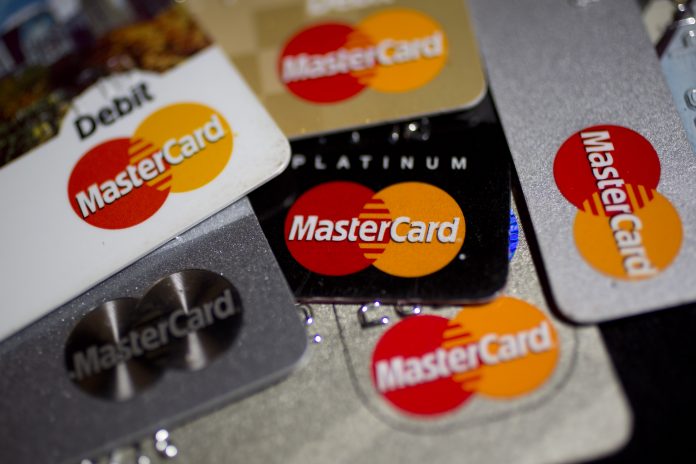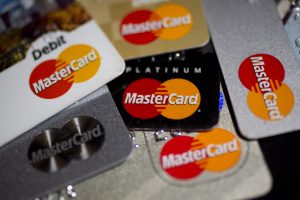
Crypto purchases boosting Mastercard customer spending.
Cryptocurrency purchases are boosting Mastercard #tictocnews pic.twitter.com/DHUXrQksPH
— TicToc by Bloomberg (@tictoc) February 1, 2018

For the first time, Mastercard is offering the ability to send money over a blockchain rather than by swiping a credit card.
After developing its own version of the bitcoin technology over the past couple of years, Mastercard (MA, +2.29%) announced Friday that it is now opening up its blockchain to certain banks and merchants as an alternative—and potentially more efficient—method of paying for goods and services.
In a sign that mainstream adoption of the technology underpinning cryptocurrency is increasing, Mastercard is the second Fortune 500 company this week to begin facilitating blockchain payments. On Monday, IBM (IBM, -0.78%) revealed that it had also begun processing payments over its own proprietary blockchain between banks in the South Pacific.
Like IBM, Mastercard is also targeting cross-border payments between businesses as the primary purpose for its blockchain, which can only be used by invitation. The Mastercard blockchain, however, differs from the tech giant’s in an important way: While the IBM blockchain only transmits money in the form of Lumens, a virtual currency created by the non-profit Stellar, Mastercard’s blockchain operates independently of a cryptocurrency, and instead accepts payments in traditional local money.
“We are not using a cryptocurrency, and we are not introducing a new cryptocurrency, because that introduces other challenges—regulatory, legal challenges,” says Justin Pinkham, a senior vice president at Mastercard Labs, who leads the credit card company’s blockchain initiatives. “If you do a payment, then what we can do is move those funds in the way that we do today in fiat currency.”
That also stands in contrast to the normal ways blockchains have typically been used until now—where they act as a ledger of transactions in the specific cryptocurrency to which they were tied, such as bitcoin and Ethereum.
On the other hand, Pinkham says, Mastercard has one advantage that the bitcoin blockchain doesn’t have: A settlement network that includes 22,000 banks and financial institutions around the world. (IBM has announced 13 banks that it plans to include in its network.) After all, Pinkham adds, companies still predominantly rely on government-issued currency to do business, making it impractical to convert cash into cryptocurrency, or vice versa, for each blockchain payment. “Even in the bitcoin system you need a bitcoin exchange that could exchange bitcoin for euro, so it creates some complications,” Pinkham says.
Mastercard hopes to provide the benefits of blockchain technology—including a more secure and transparent way of making and tracking payments—within the existing financial system, without the hassle of digital currency. “What Mastercard brings to the table here is a unique combination of that blockchain capability and Mastercard’s settlement network,” Pinkham says. (Rival credit card provider Visa, for its part, has partnered with the blockchain startup Chain to develop its own system for similar business-to-business payments.)
For one, businesses could cut costs by using the blockchain to send cross-border payments, which usually pass through several foreign banks on their way overseas, racking up fees along the way. Mastercard’s blockchain, however, could cut out those middlemen and connect a purchaser’s bank directly to that of the supplier, remitting the payment more efficiently and possibly faster, Pinkham says. (Although the transaction itself will register on the blockchain instantaneously, the funds are still moving through the same system Mastercard uses now, meaning there won’t necessarily be an improvement in speed, he cautions.)
A number of corporations have already signed up to use Mastercard’s blockchain, Pinkham says, though he declined to name any of them. Besides payments, Mastercard envisions that companies could use its blockchain to track the movement of pharmaceuticals as well as luxury goods such as handbags and diamonds, thereby reducing fraud by providing “proof of provenance.”
But consumers won’t be able to pay with the Mastercard blockchain instead of plastic, at least not anytime soon, he says. Nor does he see bitcoin as a threat to Mastercard in general. “Quite frankly, we feel that card payments are simple, safe and easier to use—and better meet the needs of consumers—than, let’s say, a cryptocurrency payment,” Pinkham adds.
So far, the evidence suggests that’s true. Despite the surge in the bitcoin price, which hit a new record surpassing $5800 last week, the number of major online retailers accepting payment in bitcoin dropped to just three this year, compared to 483 who accept Mastercard and Visa, according to Morgan Stanley.


























